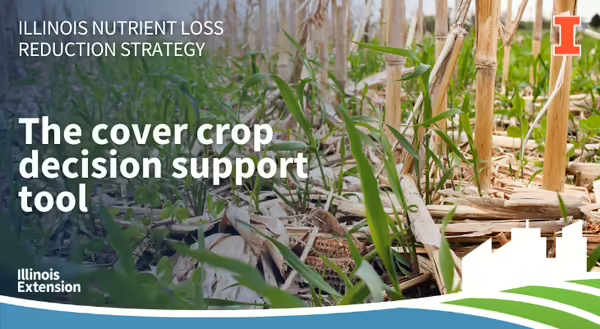
Interested in adopting cover crops but unsure what it will mean for your field? In the December 2021 NLRS Podcast episode, we go into depth on an update to the Cover Crop Decision Support Tool with Dr. Jonathan Coppess, University of Illinois Agriculture and Consumer Economics, Dr. Trent Ford, Illinois State Climatologist, Dr. Rabin Bhattarai, University of Illinois Agricultural and Biological Engineering, and Dr. Shalamar Armstrong, Purdue University Department of Agronomy.
The Cover Crop Decision Support Tool (CCDST) is a multidisciplinary tool that supports the Illinois Nutrient Loss Reduction Strategy (NLRS). The NLRS focuses on reducing nitrogen and phosphorus leaving the state while improving Illinois’ water quality. Dr. Coppess explains that cover crops are one of the most effective in-field practices available to reduce nitrogen and phosphorus loss. Cover crops not only scavenge and hold nitrogen in a time that the field would otherwise sit fallow to keep the nitrogen from going down your tile drain but also to keep soil in place which also keeps phosphorus in place. However, adding cover crops to a field comes with other concerns and considerations. Ultimately, the goal of the CCDST is to help provide site-specific answers to decisions not only surrounding the adoption but also, real-time management of cover crops by providing the best-estimated outcome for your individual field with a cereal rye cover crop.
How weather influences decisions
Dr. Ford reveals that it is vital to understand how the weather will impact decisions, especially several weeks out, so the CCDST brings in forecast information to give a more accurate outlook. The CCDST considers seasonal weather to help with future decisions and gives a realistic idea to help people make decisions regarding their cover crops. The tool uses the NOAA sub-seasonal forecasts and forecasts from the SubX program ranging from 2 – 4 weeks in duration. As updates are available from these forecasts, revisions are made to the model that supports the CCDST. The tool is unique in that the forecasts used are initialized with current and future weather conditions instead of historical data.
Why use the CCDST?
Dr. Bhattarai describes the purpose of modelling is to replicate real-world phenomena with equations and numbers. To make informed decisions surrounding the adoption of cover crops, farmers need to know how cover crops affect:
-
water dynamics,
-
tile drainage,
-
and nutrient loss.
He explains how the models used in the CCDST calculate soil moisture and how water movement influences nitrogen content in the soil profile. These models can also be used to determine how much nutrient loss reduction due to cereal rye occurs within a specific field. Cereal rye is currently the only cover crop used in the model, but the goal is to eventually include others.
Cover crop management decisions
Farmers select the actual field that they would want to grow the cover crops on, and then they provide data regarding their management plan including:
-
cash crop,
-
fertility decisions,
-
and cover crop termination method.
The tool will take the information and create a graph of the biomass of cereal rye over time, the carbon-to-nitrogen ratio of the biomass, and the percent nutrient loss reduction.
Ultimately, Dr. Armstrong explains that the goal of the tool is to visualize cover crop growth through field research, acting as a simulator. This tool is particularly useful for someone who has not used cover crops previously. It gives farmers something to think about by providing the tool user with additional information to help inform g the management decision for each field.
ABOUT THE AUTHORS
Rachel Curry is an Agriculture and Agribusiness Educator for two Nitrogen Priority Watersheds (Flint-Henderson and Lower Rock River Watersheds) and is housed in the Galva office of the Henry, Mercer, Rock Island, and Stark Counties Extension Unit. Rachel earned a BS in Environmental Studies from Knox College and an MS in Environmental Science and Soil Science from Iowa State University with an emphasis on soil fertility. She is interested in sharing information on the Illinois Nutrient Loss Reduction Strategy and agricultural conservation practices through discussion and outreach.
Nicole Haverback is a Watershed Outreach Associate for two Phosphorus Priority Watersheds (Embarras and Little Wabash River Watersheds) and is housed in the Effingham office of the Clay, Effingham, Fayette, and Jasper Counties Extension Unit. Nicole earned a BS in Agriculture and Rural Policy Studies from Iowa State University in May of 2022. She is interested in sharing information on the Illinois Nutrient Loss Reduction Strategy and agriculture conservation practices through discussion and outreach.
Sam Henry is an Agricultural Engineering student at the University of Illinois. Outside of classes, she works with Dr. Rodriguez in his BioMASS Lab, and learns about alternative agricultural methods in Illini Urban Farmers. She is in her third year, and is passionate about the nexus of clean water, sustainable agriculture, natural resources, and sustainability.
ABOUT THE BLOG
At Illinois Extension, we’re working to improve water quality at home and downstream. Every month, our watershed outreach associates will bring you stories highlighting agricultural conservation practices, current research projects and results, and from the field farmer interviews. The Nutrient Loss Reduction blog covers conservation practices recommended by the Illinois Nutrient Loss Reduction Strategy, timely updates, farm safety, and new decision tools to help farmers and producers reduce the nutrients leaving their field. Want to get notified when new blog posts are available? Subscribe at go.illinois.edu/SubscribeINLRS.